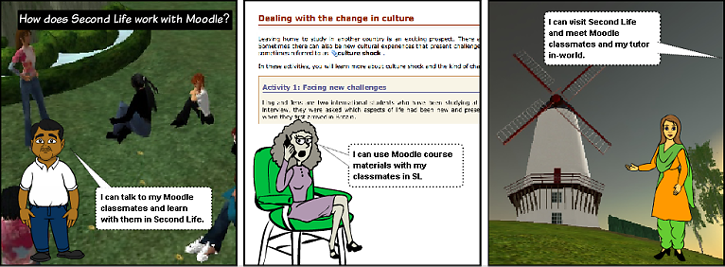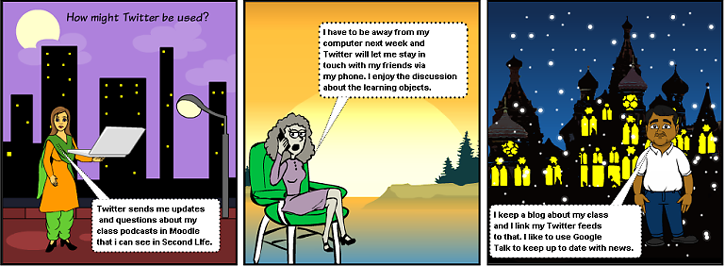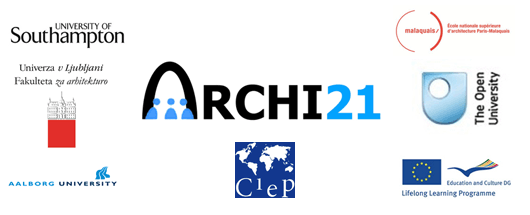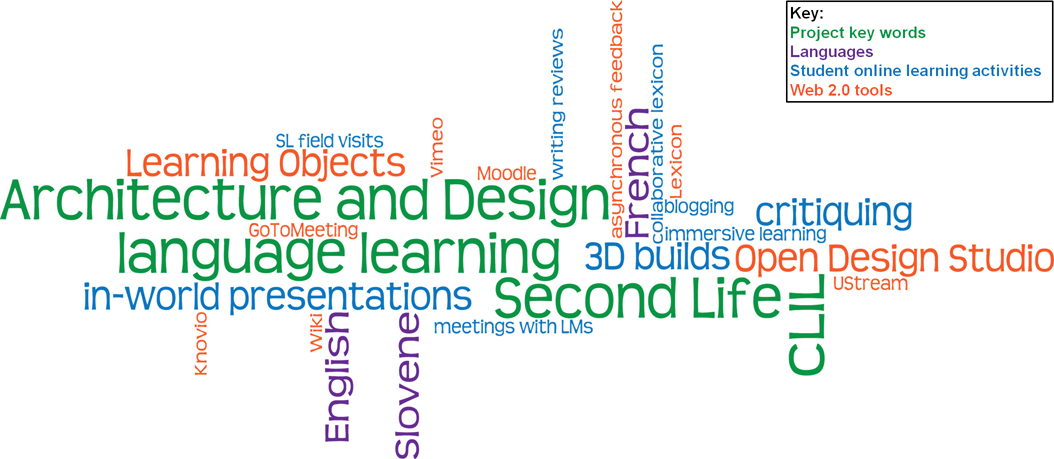3D Immersive World Projects
Highlights
The eLanguages team led and took part in a number of projects exploring teaching and learning in Second Life.
Between 2007 and 2014, eLanguages was involved in a number of projects exploring the use of Second Life in teaching and learning. These included projects which investigated the use of Second Life in the teaching and learning of languages in 3D immersive worlds (Cardenio and M3: MUVE, Moodle and Microblogging), and a CLIL (Content and Language Integrated Learning) approach to the teaching of European students of Architecture and Design using immersive worlds (the ARCHI21 Project).
eLanguages was also been involved in helping to create the University of Southampton island in Second Life, and developing an area on the island representing the Modern Languages and Linguistics department at the University of Southampton.
Three of the key projects we were involved in were:
- Cardenio: The intercultural experience
- M3 - MUVEs, Moodle and Microblogging: Communities on the move
- ARCHI21: Architectural- and Design-based Education and Practice through Content and Language Integrated Learning using Immersive Virtual Environments for 21st Century Skills
Cardenio: The intercultural experience
In 2007, the Cardenio project explored the potential of Second Life for enhancing the study of language learning and area studies. Supported by the Higher Education Academy, the project sought to identify the benefits for participants engaged in pursuing a shared interest in language teaching and learning.
Project aims and objectives:
- To investigate how a group of Second Life (SL) residents, with a shared interest, interact with and optimise the 3D online environment to achieve their collaborative aims
- To identify from the residents' perspective what the specific affordances of the Second Life MUVE (Multi-User Virtual Environment) might be in terms of their goals
- To observe the potential of the MUVE for the acquisition of higher-level skills including those of negotiation, conflict resolution, intercultural, personal and creative skills. (Hudson, 2006)
The project set out to do this by:
- bringing together new SL users (language teachers and educators) and experienced SL residents to form a small self-supporting project community;
- investigating notions of culture and personal identity in SL through a series of in-world search tasks and blog discussions;
- exploring the potential of SL for informal learning and more specifically as a platform for specific language learning and teaching purposes.
The project community
Participants in the project consisted of volunteers from two different communities and representing a range of nationalities: professional language teachers and educators with a specific interest in exploring the potential of SL for intercultural exchange, language teaching and learning, and a community of experienced SL residents with diverse interests in aspects of the project.
Outcomes
- A range of different and interesting perceptions of culture and personal identity were reflected by SL search tasks and blog postings
- Bonds formed between group members, and contact through the in-world community continued after the project
- Modern Language teachers produced proposals for using SL to support students' language learning and for acculturation purposes
M3 - MUVEs, Moodle and Microblogging: Communities on the move
A JISC-funded project in the Users and Innovation Programme
Project Description
In 2008, the M3 project set out to explore the potential of the VLE, Moodle, a Microblogging tool, Twitter, and the MUVE, Second Life, with three different groups of users within the educational community and compare integrated use of these tools and environments. A key aim was to investigate effective ways of embedding synchronous online tools, which are already establishing themselves as effective for social networking, and exploring the use of others that offer a 3-dimensional opportunity for learning. A Twitter plug-in for Moodle was to be one key deliverable of the project.
The first two groups of participants comprised student communities involved in a language learning/acculturation course and/or studying educational technologies, one involving primarily face-to-face interaction, and the other learning at a distance online and potentially, 'on the move'. A particular interest was in using this approach with international students undertaking a tutored online course entirely at distance before coming to the UK to begin studies in higher education. The final group were to be recruited from interested parties from within the Second Life and JISC communities, including teachers, researchers and Second Life practitioners.
Aims and Objectives
- Explore the use of a social networking tool (Twitter) for creating a ubiquitous and personalised learning environment for students
- Build on current work within the Second Life (MUVE) community using a next generation emergent technology to create an immersive learning experience
- Adapt an existing Moodle course to create a hybrid Moodle/Second Life solution, which might potentially enable the transition to a course taught exclusively in Second Life
- Adapt some of the existing activities and learning materials (developed as 'learning objects' and vidcasts) for use with the microblogging tool, Twitter, and the Second Life environment
- Use Twitter to enable a convergent technology to promote discourse within the learner community, and to enrich the course experience
- Explore the potential of Twitter with a final group of educators based outside the language learning community
Achievements
- A set of Twitter blocks have been developed and tested for Moodle and are now being further enhanced, allowing use of the microblogging tool within the Moodle VLE
- An existing set of online course learning activities and resources have been effectively adapted and enhanced for use in Second Life and with Twitter, offering students an immersive learning experience as part of their online course
- Student response to the use of these emerging technologies within teaching and learning contexts has been gauged and found to be broadly positive and encouraging
- Educators based outside the language learning community have also responded favourably to the project's Twitter and Second Life developments
Twitter plugins for Moodle
The code and instructions for the set of Twitter blocks developed for Moodle can be found at https://code.google.com/archive/p/m3-twitter-moodle-blocks/. Please note these blocks are open-source beta versions. They require further work to be fully functional. If you download and improve them, please email us and share your changes so that we can disseminate further.
M3 Project documents
Further information about the M3 project can be found on the M3 Project page on the JISC website. The M3 Project final report is available from the JISC website.
M3 Project dissemination
MUVE, Moodle and a Microblogging Tool: Blending technologies to prepare international students for language and life in the UK. Presentation at Eurocall 2009 Conference (9-12 September), Gandia, Spain: Presentation (pdf, 602kb).
Diagram 1: The M3 project can offer a means to keep a virtual learning community connected through personalised delivery and contribution of content as shown in the diagram below. Click to see a larger version.

Diagram 2: How does Second Life work with Moodle? Click to see a larger version.

Diagram 3: How might Twitter be used? Click to see a larger version.

ARCHI21: Architectural- and Design-based Education and Practice through Content and Language Integrated Learning using Immersive Virtual Environments for 21st Century Skills
The eLanguages team in Modern Languages and Linguistics together with colleagues in the School of Education at the University of Southampton were part of a consortium of European universities conducting research into architectural design, education and practice through Content and Language Integrated Learning (CLIL) using the Second Life immersive virtual environment. The consortium received funding over two years under the EU LLP Transversal Programme, beginning in November 2010. Overarching much of the teaching, learning and research activity in the project is an Archi21 island in Second Life which can be visited in order to experience some of the outputs from the project more directly. Search for 'ARCHI21' or go directly to the SLURL.
Since January 2011, a number of courses integrating content (Architecture and Design) and one or more of the project's languages (English, French or Slovene) have been delivered. These have attempted to blend a range of new technologies and harness the potential of an immersive virtual environment for the teaching of architecture, design and languages. Classes have been conducted in Second Life and a team of Language Mediators (trainee language teachers) from the School of Education have been assisting in-world, and by offering support to students asynchronously using the affordances of the internet.
There was a dedicated ARCHI21 project website (this link is to the archived version).
One deliverable from the project is a set of interactive learning objects relating to the teaching and learning of Architecture and Design and additional languages. These learning objects are licensed under a Creative Commons Attribution-NonCommercial-NoDerivs Licence (CC BY-NC-ND) (users may link to any or all of the interactive items):
- Introduction to lighting for architectural design
- Lighting for architectural design in 3D virtual worlds
- Using virtual models in architectural planning
- Describing form in Slovene
- Introduction to Cybergogy
- Introduction to the notion of fragility in architecture and design
- Exploring dimensions of fragility in urban design and architecture
- Architecture and fragile ambients
- Understanding the content and language of design briefs
- Listening to a presentation and part of a critique in architectural design
- Language use in presentations about architectural design
- Analysing a design critique
- Writing critiques in the field of architecture and design
- Ecouter la présentation et un extrait de la critique d'un projet architectural
- L'usage de la langue pour présenter un projet architectural
- Approaches to style in architecture and design
- Uvod v pomen pojma občutljivosti v arhitekturnem in oblikovalskem kontekstu
- Spoznavanje razsežnosti pojma občutljivosti v urbanem oblikovanju in arhitekturi
- Comprendre ce qu'est un cahier des charges et comment on l'écrit
The project and its dedicated island are also featured on the Second Life Academic Showcase.





 eLanguages on LinkedIn
eLanguages on LinkedIn eLanguages on Facebook
eLanguages on Facebook e_languages on Twitter
e_languages on Twitter elanguages_ on Instagram
elanguages_ on Instagram